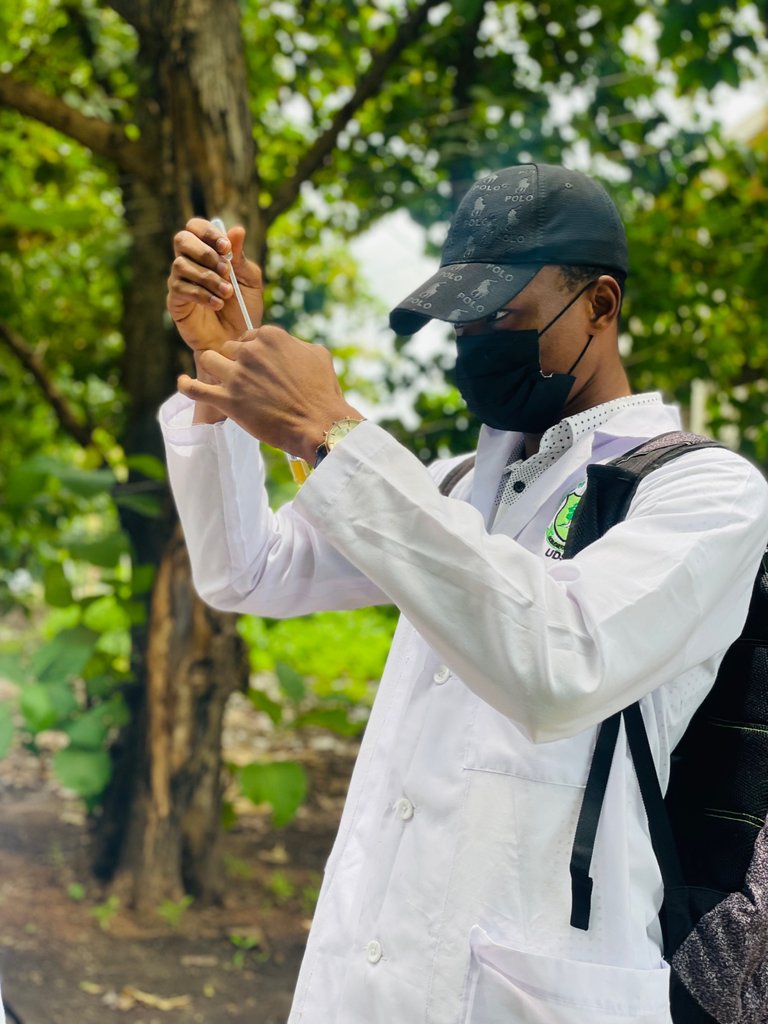Practical Sessions In The Bush Lab - Phytochemical Analysis of Kenaf Leaf

Hello fellow students, it feels great to finally post in the hivestudentshub, a community dedicated for us students. Thanks to the leaders and moderators of the community for their continuous good works.
As some of you are aware, I am a biochemistry student studying in the University of Development Students, Navrongo. We have practical sessions on a regular and this particular one we did sometime ago, I ended up liking a lot.
I don’t know how I didn’t know my school had 2 chemistry labs all this while😅. We used the one so much that a lot of us were surprised when we had to carry out this lab session in the other lab.
“The bush lab” as it’s called is this other lab.😂 And yes, I am not exaggerating it’s actually in the bush. @abu78, @nhaji01 and @depressedfuckup can relate. How did you guys feel when you heard about the bush lab?

So we were divided into groups of six (6) for this practical session and it was themed a “mini practical session” preparing us for our final presentation. All groups were tasked on ”phytochemical screening of some leaves”. My group worked on the phytochemical analysis of the kenaf leaf.
The process is pretty easy and straightforward. All we needed to do was locate some kenaf leaves, homogenize, soak it for some time and dry it.
For the non chemists here 😜, phytochemical screening here is the testing for the presence of secondary mentalities in the plant leaves. Secondary metabolites are the metabolites that are not involved in the growth and development processes of the plant but they have their ecological effects and are sometimes produced in response to external attacks.
The secondary metabolites my group tested for were saponins, flavonoids, tannins, glycosides and alkaloids.
Below is how the tests were carried out.
Materials used and methods.

The group used a kenaf leaf extract, filter papers, boiling bath, measuring cylinders, funnels, distilled water, tap water, ethanol solution, hydrochloric acid, test tubes, evaporation dish, sulphuric acid, pipette, weighing scale, ferric chloride, regnant reagent, sodium hydroxide, and acetic acid.
- Preparation of leaf for testing.
The kenaf leaf was dried at room temperature, for four days. It was then blended in our case with a mechanical blender to obtain a powdered sample. 37g of the sample was dissolved in 370mL of water and was left to stand for about 48 hours. It was filtered and subjected to qualitative analysis for the metabolites.
- For saponins.
The group measured 10mL of the test which was shaken vigorously for 5 to 10 minutes. There was then formation of froth which slowly disappears. This observation can be inferred as a positive test for saponins.
- For Flavonoinds.
3 drops of NaOH was first added to the sample and observation was made. Yellow coloration appeared. NaOH was again addded in excess and a deep yellow color appeared. These inferred that flavonoids were present.

- For steroids.
2 drops of sulphuric acid was added to 2 ml of the sample and an orange color appeared. Sulphuric acid was added in excess and the orange color changed to brown. This inferred that steroids and terpenes could be present.

- For alkaloids.
2 ml of sample was taken out and 1 drop of wagner reagent added. A deep brown color appeared which inferred the presence of alkaloids.

- For tannins.
3 drops of ferric chloride was added to 2 ml of the sample and a green color appeared. The ferric chloride was added in excess and the green turned deep. Tannins was suspected to be present.

- For Glycocides.
2 drops of acetic acid added to 2 ml of the sample resulted in no color change. The was the first non color observation made of the day and so that got us thinking.
2 drops of ferric chloride was added and a deep green coloration appeared and then 2 drops of sulphuric acid was added and deep brown color was formed. Effervescence was observed as well. All these inferred that glycosides could be present.

@abu78 busy with his work
The deep brown colorations suggest that the metabolites are in high quantities while the lighter colors tell us they are in less quantities.
From the experiment, we concluded that the kenaf leaf contains alkaloids, glycosides, steroids, flavonoids, tannins and saponins.

Overall, it was a fun experience in the bush lab for a first time and I wish we could do practicals there more.😅
We did a presentation on this experiment but I’ll leave that for another day.
For me, I would always prefer the bush lab. I could get some bush meat and eat while having practicals🤣🤣.
All the day it’s fun reading and learning from this. Thanks for sharing
😂 there are no bush meats in this lab oo.
Man! God knew I avoided going into that bush.😂😂
It was all fun and I really enjoyed doing it since we don’t get to do much of practical work.
You couldn’t escape your faith😂. It was pretty cool and I hope we get to do more of these.
I hope so too.